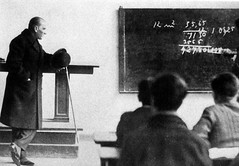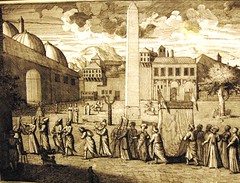Liberation

Liberation
Originally uploaded by DJ Axis.
erülke

14
Originally uploaded by ozguremreozturk.
Türk Genci, devrimlerin ve cumhuriyetin sahibi ve bekçisidir. Bunların gereğine, doğruluğuna herkesten çok inanmıştır. Yönetim biçimini ve devrimleri benimsemiştir. Bunları güçsüz düşürecek en küçük ya da en büyük bir kıpırtı ve bir davranış duydu mu, "Bu ülkenin polisi vardır, jandarması vardır, ordusu vardır, adalet örgütü vardır" demeyecektir. Elle, taşla, sopa ve silahla; nesi varsa onunla kendi yapıtını koruyacaktır.
Polis gelecek, asıl suçluları bırakıp, suçlu diye onu yakalayacaktır. Genç, "Polis henüz devrim ve cumhuriyetin polisi değildir" diye düşünecek, ama hiç bir zaman yalvarmayacaktır. Mahkeme onu yargılayacaktır. Yine düşünecek, "demek adalet örgütünü de düzeltmek, yönetim biçimine göre düzenlemek gerek"
Onu hapse atacaklar. Yasal yollarla karşı çıkışlarda bulunmakla birlikte bana, başbakana ve meclise telgraflar yağdırıp, haksız ve suçsuz olduğu için salıverilmesine çalışılmasını, kayrılmasını istemeyecek. Diyecek ki, "ben inanç ve kanaatimin gereğini yaptım. Araya girişimde ve eylemimde haklıyım. Eğer buraya haksız olarak gelmişsem, bu haksızlığı ortaya koyan neden ve etkenleri düzeltmek de benim görevimdir."
İşte benim anladığım Türk Genci ve Türk Gençliği!

İshak Paşa Sarayı/ Türkiye
Originally uploaded by asunsal.
Ağrı Dağı'nın yakınında, Doğubeyazıt'ın 5 kilometre uzağında eski Doğubeyazıt yanında sarp kayalar üzerine kurulmuş, kartal yuvasını andıran 116 odalı bu saray aslında türbesi, camii, surları, iç ve dış avluları, divan ve harem salonları, koğuşları ile bir bey kalesidir.
Sarayın yapımını 1685'de Doğubeyazıt Sancak Beyi Çolak Abdi Paşa başlatmış, oğlu Çıldır Valisi İshak Paşa ve onun oğlu Mehmet Paşa tarafından 1784'te bitirilmiştir. 7.600 m² bir sahada yapılan sarayın inşaası 99 yıl sürmüştür.
Türk mimarisinin en güzel örneklerinden olan İshakpaşa Sarayı; Türkistan, Selçuklu ve Osmanlı mimari özelliklerini birleştiren bir yapıdır. Camiinin kubbeleri Türkistan kubbeleri gibidir. Saray Topkapı Sarayı'nı andırır, kapıları ise Selçuklu stilindedir.
50 x 115 metre alanı kapsayan sarayın Harem Dairesi iki katlı, diğer bölümleri tek katlı idi. Günümüzde ikinci kat tamamen yıkılmış durumdadır. Saraya ancak doğudaki tepeden açılan bir kapıdan girilir. Diğer tarafları 20-30 metre yükseklikte sağlam duvarlarla çevrilidir. Kapıdan, önce dış avluya girilir. Dış avlunun etrafında uşak ve seyis odaları ve tavlalar vardır. Dış avludan iç avluya kemerli tak şeklinde büyük bir kapıdan girilir. İç avluda çeşitli odalar ve koğuşlar vardır. Ortadaki harem dairesinin duvarlarında İshak Paşa'yı öven yazılar bulunmaktadır. Kapının iki yanında iki aslan heykeli vardır. Divan odası (toplantı salonu) ise 20 metre genişlik ve 30 metre uzunluktadır.
Ruslar, Doğubeyazıt'ı işgal ettiklerinde, burasını karargah olarak kullanmış ve saraya ait kıymetli eşyaları yanlarında götürmüşlerdir. Bugün, sarayın 13 x 6,5 metre ebadındaki som altından yapılan kapısı Moskova Müzesi'ndedir.
Aynı zamanda, dünyanın ilk kalorifer tesisatı döşenen sarayıdır.
Eskiden sarayın olduğu yer, sarayın tam ortada bulunduğu bir yerleşim merkeziydi. Ova tarafında evler, diğer yanlarda camiler, mezarlık ve diğer yapılar vardı. Fakat bu yapıların hepsi yıkılmıştır. Saray son yıllarda yapılan tamirat ile tamamen yıkılmaktan kurtarılmıştır.

Kabe-i Muazzama
Originally uploaded by karanlikay.
Allah'ım! Sen kullarını kutsal beytini ziyarete çağırdın. Ben de Senin rızanı istemeye geldim. Sen bunu bana nasip ettin. Beni bağışla, bana merhamet et, bana sağlık ve afiyet ver ve beni affet. Senin herşeye gücün yeter.

O ölümsüzdür - هوالباقی
Originally uploaded by meliha`.
Yer: Galata Mevlevihanesi kabristanı
Ta'lik hatla yazılmış bir mezartaşı kitabesi..
Mezartaşlarının ilk cümlesi genellikle bu şekildedir. "Hüve'l-Baki". O ölümsüzdür. Böylelikle ondan gayrısı ölümlüdür, fanidir.

Lala Mustafa Pasa Mosque
Originally uploaded by baby7.
LalaMustafaPasa The building which was constructed between the years 1298-1312 in the Lusignan period is one of the most beautiful Gothic structures of the Meditteranean region. The Lusignan kings would be inaugurated as the King of Cyprus at the St. Sophia Cathedral in Nicosia first, and following this they would be crowned as the King of Jerusalem at the St. Nicholas Cathedral in Famagusta. These ceremonies continued to be held until 1571 when the cathedral was turned into a mosque by the Ottoman Turks.

Kanuni Sultan Suleyman
Originally uploaded by ProfDrZihniSinir.
New York Metropolitan Museum of Art

Sultanahmet Meydani
Originally uploaded by ProfDrZihniSinir.
New York Metropolitan Museum of Art

Arabic word for "God" (inscriptions)
Originally uploaded by EEY.
Some of the biggest misconceptions that many non-Muslims have about Islam have to do with the word "Allah". For various reasons, many people have come to believe that Muslims worship a different God than Christians and Jews. This is totally false, since "Allah" is simply the Arabic word for "God" - and there is only One God. Let there be no doubt - Muslims worship the God of Noah, Abraham, Moses, David and Jesus - peace be upon them all.

The Ortakoy Mosque-Istanbul *Daniela
Originally uploaded by istanbul_love.
The area of Ortakoy is magical mainly because of this mosque. 10 metres away from this mosque is the most popular rock bars of Turkey. It's also full with cafe's to play tavla (backgammon), smoke some "nargile" and to drink some cay (chay/ tea). In Ortakoy there are churches, a synagogue and this beautiful mosque. All religions in the same area. The mosque is on the European side of the city and the birdge connects to the Anatolian side of the city.

bukhara
Originally uploaded by roadwarrior.
the main entrance for the Mir-i Arab madrassa, built circa 1535 AD when Bukhara was the prosperous capital of the uzbek kingdom.

Hamam
Originally uploaded by mopsy_slaughter.
An authentic Turkish bathhouse which is now a museum about bathhouses. All caption were in Albanian so I don't know a damn thing more about bathhouses than I did going in.

Seni anıyoruz, arıyoruz ve özlüyoruz...
Originally uploaded by broadcasterTR.
Mustafa Kemal Pasha (1881-1938), also referred to as Kemal Ataturk ('Father of the Turks') served in field commands during World War One and subsequently became Turkey's first president.
Born in Salonika Kemal graduated from the Turkish Military Academy in 1902. Chiefly interested in military progression he nevertheless participated in early revolutionary activities while serving as a junior officer.
Regarded as a potential rival by Enver Pasha, the most prominent figure in the country's Young Turk administration, Kemal was packed off to Bulgaria as Turkish military attaché and remained there when European war broke out in August 1914.
With the Ottoman Empire's entry into the war in November 1914 Kemal was given command of the 19th Division based at Gallipoli. His fanatical determination to throw back the Allied invasion there and at Suvla Bay in 1915 manifested itself in repeated attacks, often at great cost. His defiant stand sparked admiration and transformed him into a popular figure at home.
Promoted General in the wake of his success at Gallipoli he was subsequently transferred to the Caucasus in 1916 where he proved rather less successful in the face of challenging odds. He nevertheless came out of what was a disastrous summer offensive for the Turks with greater credit than most.
The following year saw Kemal lead Second Army at Aleppo as part of a wider German-led force. In October 1917 he resigned in protest at Enver Pasha's conduct of the Caucasian campaign but returned in August 1918 at the head of Seventh Army to conduct its retreat following defeat at Megiddo. Shortly before the armistice took effect in October 1918 Kemal was given overall command of Ottoman forces north of Aleppo.
Unaffected by the collapse of the Young Turk administration (with most of the leadership fleeing to Germany) Kemal organised nationalist forces in Anatolia against Allied division of Turkey. Incensed by the terms of the Treaty of Sevres - which effectively reduced the Ottoman Empire to Turkey itself - Kemal announced the establishment of a provisional government.
After successfully leading a guerrilla campaign against the Greek army's attempt to occupy Smyrna Kemal deposed Sultan Mehmed VI (abolishing the sultanate and in 1924 the caliphate) and became Turkey's first president in 1924, serving until 1938.
As president (and effective dictator) Kemal radically transformed Turkish society, politics and law; its citizens adopted Western standards of dress, the Latin alphabet, secularism and industry.
Awarded the title 'Ataturk' - 'Father of the Turks' - by the National Assembly in 1934 Kemal died on 10 November 1938 in Istanbul the most significant figure of his generation.

Turk's Head Mosaic
Originally uploaded by jaqian.
Outside a popular bar on Parliament Street, Dublin.

Diwani Script
Originally uploaded by I.N.N.E -R- E.A.L.I.T.Y.
The Diwani script is a cursive style of Arabic calligraphy
developed during the reign of the early Ottaman Turks( 16th-early 17th century).

Mevlevi Dervishes Perform...
Originally uploaded by Kıvanç.
Mevlevi Dervishes Perform. ( Sultanahmet - İstanbul - Turkey )
Mevlevi : The Mevlevi Order or the Mevleviye are a Sufi order founded by the followers of Jalal ad-Din Muhammad Rumi in 1273 in Konya (in Turkey at present). They are also known as the Whirling Dervishes due to their famous practice of whirling as a form of dhikr (remembrance of Allah). Dervish is a common term for an initiate of the Sufi Path.
Principles
The Mevlevoopee, or Mevleviye, one of the most well known of the Sufi orders, was founded in 1273 by Rumi's followers after his death, particularly his son, Sultan Veled Celebi (or Çelebi, Chelebi). The Mevlevi, or "The Whirling Dervishes", believe in performing their dhikr in the form of a "dance" and music ceremony called the sema.
The Sema represents a mystical journey of man's spiritual ascent through mind and love to "Perfect." Turning towards the truth, the follower grows through love, deserts his ego, finds the truth and arrives at the "Perfect." He then returns from this spiritual journey as a man who has reached maturity and a greater perfection, so as to love and to be of service to the whole of creation.

Fatehpur Sikri
Originally uploaded by Victor Bautista.
Fatehpur Sikri, Uttar Pradesh
Once a political capital of India's mughal empire from 1571 to 1585 under Akbar's reign.
Made predominantly of red sandstone, the architecture shows different influences from Hindu and Jaina architecture.
bu tamanen ayri bir kultur...
dunyanin hicbir yerinde bizim kadar zengin ve saglikli bir kahvalti masasi bulamazsiniz...
ovunmek gibi olmasin ama gercekten bizim mutfagimiz her damaga uygun :)
 ilk önce boş ve uygun bir araziye yarım metre temel kazacağız.Bu arazi tam komşunun 20 cm yanından başlayıp diğer komşununda duvarına bitişik olmalıki iki komşunun arasına girsek bile
ilk önce boş ve uygun bir araziye yarım metre temel kazacağız.Bu arazi tam komşunun 20 cm yanından başlayıp diğer komşununda duvarına bitişik olmalıki iki komşunun arasına girsek bile
birbileriyle bizim evin arasından konuşabilsinler(aynen yaşanmış bir olaydır:) camlar açıkken iki komşu görüşüp sanırım annaştılar) neyse devam edelim bu temeli(ki yarım metre olduğunu söylemiştik temelcik oluyor) taşla doldurup üzerine tuzluk yardımı ile güçlendirdiğimiz çimento ve kum karışımı ile sağlamlaştıralım...
neyse devam edelim bu temeli(ki yarım metre olduğunu söylemiştik temelcik oluyor) taşla doldurup üzerine tuzluk yardımı ile güçlendirdiğimiz çimento ve kum karışımı ile sağlamlaştıralım... sonra odaları ortaya çıkalım zaten temeli de o şekilde kazdık...aman dikkat sütün atmayalayım...o neki öle ne gerek var hem sadece iki kata sütün mü lazım olur?
sonra odaları ortaya çıkalım zaten temeli de o şekilde kazdık...aman dikkat sütün atmayalayım...o neki öle ne gerek var hem sadece iki kata sütün mü lazım olur? duvarları örerken dikkat edelim aman gene çimento fazla kullanmayalım çünkü 20 30 sene sora (ki sert rüzgarlar esipte evi uçurmazsa depremi hiç hesaba bile katmıyorum)evi beğenmezsek söküp başka yapacağız ve kullandığımız tuğlaları bir daha kullanacağız.tüm tuğlalar kullanılmış ikinci el nasıl oluyorsa?
duvarları örerken dikkat edelim aman gene çimento fazla kullanmayalım çünkü 20 30 sene sora (ki sert rüzgarlar esipte evi uçurmazsa depremi hiç hesaba bile katmıyorum)evi beğenmezsek söküp başka yapacağız ve kullandığımız tuğlaları bir daha kullanacağız.tüm tuğlalar kullanılmış ikinci el nasıl oluyorsa? işte oldu ortaya çıktı evimiz ...bi temiz sıva bir de boya cillop gibi ev işte :)
işte oldu ortaya çıktı evimiz ...bi temiz sıva bir de boya cillop gibi ev işte :)
erülke

My blog is worth $2,822.70.
How much is your blog worth?